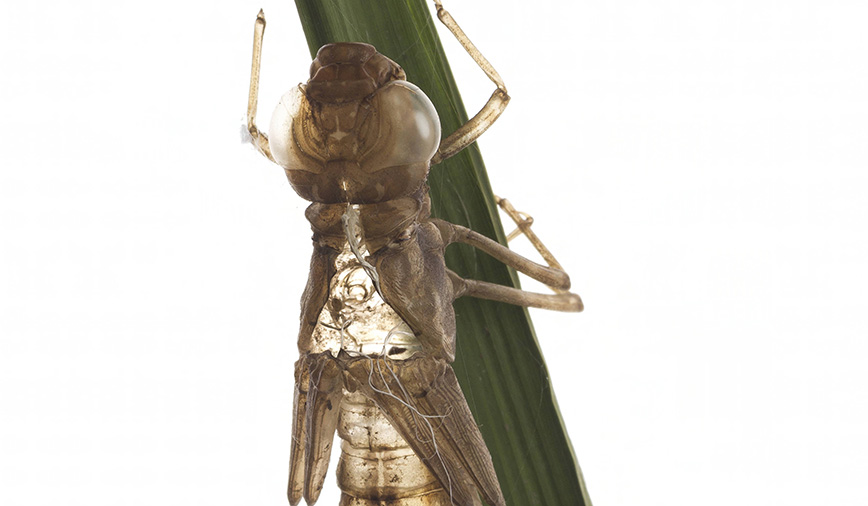When you write a weekly column about nature, spring can be a really tough time—though not for lack of subject matter. (Matter of fact, when you write a weekly column about nature, a lack of subject matter is never a problem!) Rather, the issue is too many subjects. Sap’s flowing, trees are budding, flowers are blooming, birds are migrating. Talk about topic overload.
This week was no exception. Looking for a little focus, I reached for a field guide…and that’s when inspiration hit. Or fell. Well, actually, it kind of floated into my lap.
“It” was a shed exoskeleton from one of our household spiders. (Don’t ask which type. We have lots—go figure—and this particular shed was quite small.) As the little artifact wafted through the air, the column-writing lightbulb came on; with a gleeful “Aha!” I let the words begin to flow.
Exoskeletons are an example of what I think of as anonymous nature—the sort of stuff so commonplace that it’s often overlooked, and therefore little known.
Exoskeleton literally means “outside skeleton” and it refers to the hard outer covering of many animals that don’t have endoskeletons, or “inside skeletons,” like we do. The group (phylum) of animals with exoskeltons is called Arthropoda and includes crustaceans like lobsters and crayfish; myriapods like millipedes and centipedes; insects; and of course spiders.
Simply put, that’s a lot of critters. One estimate puts the amount of arthropods at 85% of the total animal biomass on earth. That means if you took every animal around—including elephants and blue whales as well as ants and fleas—and weighed them on a giant scale, 85% of that total weight would be arthropods. At any given moment, there are about a million trillion (1,000,000,000,000,000,000) insects (not including all the other arthropods) crawling around the earth. Not only is that a lot of critters, that’s a heck of a lot of exoskeletons.
Most exoskeletons are made out of chitin, a tough, semitransparent substance that protects the inside of an arthropod the way a helmet protects your head. In your case, when your head grows, it’s time to buy a bigger helmet. In the case of arthropods, growth means it’s time to shed.
The process of shedding is known as molting, or ecdysis. Most arthropods molt many times as they grow from juvenile to adult. Some eat the shed skin, also known as an exuvia, to recycle the proteins and polysaccharides it contains, but others, like spiders, do not.
Ecdysis is not without consequences. Prior to a molt, an arthropod usually stops eating and looks for a safe haven in which to shed. The actual molt may take a few minutes to several hours, depending on the size of the critter and the intricacy of its body parts; afterward, the animal must remain still while the new exoskeleton hardens. Sometimes complications come up and the animal dies mid-molt; other times, predators come up and slurp! No more arthropod. Freshly molted, these animals a soft, easy-to-capture meal. (Picture peel-and-eat shrimp, already peeled.)
A cast-off, empty spider exoskeleton can be an exciting find if you’re a fan of spiders, and quite the opposite if you’re not. I remember a time a few years ago when the tarantula that lived on my desk molted. My boss Jim—not a fan of big, hairy spiders—saw the crumpled remains of Miss Spider’s skin sitting in a heap in her aquarium and practically jumped for joy…until he saw the bigger, better Miss Spider flexing her bigger, better body at the opposite end of the cage.
The next time you notice a spider, watch it for a minute or two. Is it moving? Is it dead? Take a closer look—it may just be an exoskeleton. And the spider who shed it may be lurking right…over…there…
Pam Otto is the manager of nature programs and interpretive services for the St. Charles Park District. She can be reached at potto@stcparks.org or 630-513-4346.

